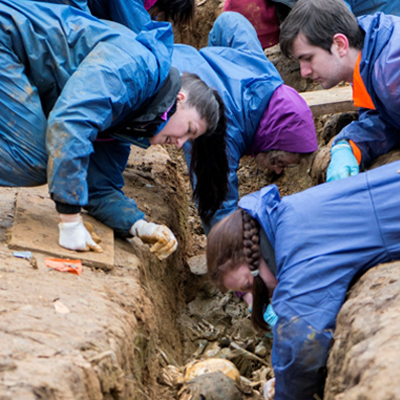Contact Dr Hannah Moore
- Tel: +44 (0) 1234 988466
- Email: H.E.Moore@cranfield.ac.uk
Background
Hannah completed her dual honours degree in Chemistry and Forensic Science followed by her PhD in Analytical Chemistry applied to Forensic Entomology at Keele University. Hannah then spent a few years in industry specialising in Mass Spectrometry before starting at Cranfield University in 2016.
Hannah's research interests lie heavily within the field of forensic entomology, specialising in cuticular hydrocarbons of forensically important insect species. Her multidisciplinary approach combines analytical chemistry, statistical analysis and artificial intelligence to provides a revolutionary way to identify and age insects. Hannah is highly research active as well as being one of only two operational forensic entomologists in the UK. Hannah regularly attends high-profile homicides, disasters such as Grenfell Tower and court as an Expert Witness.
Hannah is an experienced Senior Lecturer within the Cranfield Forensic Institute but also delivers vital training outputs for the UK police forces in forensic entomology scene collection. Hannah is also a Scientific Board Member of the European Association of Forensic Entomology.
Research opportunities
Hannah is open to hear from researchers in the field of (forensic) entomology, taxonomy, taphonomy and artificial intelligence as well as law enforcement for collaborative research projects.
Hannah is currently a guest editor of a special issue in the journal Insects: 'Advanced Techniques in Forensic Entomology'.
Current activities
Hannah's research interests lie heavily within the field of forensic entomology, specialising in cuticular hydrocarbons of forensically important insect species. The extracted hydrocarbons are analysed using gas chromatography-mass spectrometry (GC-MS) and the data from the chromatogram can then be subjected to statistical analysis in the form of Principal Component Analysis (PCA) or Artificial Neural Networks (ANN). The chemical profiles of the insects allow for identification (as all insects have a 'fingerprint', species-specific hydrocarbon profile) as well as the age, enabling minimum Post Mortem Intervals (PMImin) to be calculated.
Hannah is also expanding this identification technique into conservation projects working closely with museums to tackle the current issue of insect decline due to climate change and land use.
Hannah is the Director of the Forensic Programme and the Course Director for the Forensic Investigation MSc.
Hannah is a reporting forensic entomologist which enables her teaching to be research and operationally led. She also attends court as an expert witness.
Clients
Hannah has numerous academic and industrial collaborations and partnerships from commercial collaborators such as The Forensic Training Partnership, Forensic Access, UK Police Forces, Spectrometric, JEOL to HEI e.g. Keele University, Frankfurt University, Texas A&M, University of Michigan as well at the Natural History Museum, London and the Oxford University Museum of Natural History.
Publications
Articles In Journals
- Kula C, Amendt J, Drijfhout FP & Moore HE. (2023). Geographical Variation of Cuticular Hydrocarbon Profiles of Adult Flies and Empty Puparia Amongst Three Populations of Calliphora vicina (Diptera: Calliphoridae). Journal of Medical Entomology, 60(1)
- Moore H, Lutz L, Bernhardt V, Drijfhout FP, Cody RB, .... (2022). Cuticular hydrocarbons for the identification and geographic assignment of empty puparia of forensically important flies. International Journal of Legal Medicine, 136(6)
- Cody RB, Sparkman OD & Moore H. (2022). Creating a Searchable Chromatographic Database with the NIST Mass Spectral Search Program. Journal of the American Society for Mass Spectrometry, 33(4)
- Moore HE, Hall MJR, Drijfhout FP, Cody RB & Whitmore D. (2021). Cuticular hydrocarbons for identifying Sarcophagidae (Diptera). Scientific Reports, 11(1)
- N.A. NA. (2021). Juvenile hormone: Production, regulation, current application in vector control and its future applications. Tropical Biomedicine, 38(3)
- Moore HE, Butcher JB, Day CR & Drijfhout FP. (2017). Adult fly age estimations using cuticular hydrocarbons and Artificial Neural Networks in forensically important Calliphoridae species. Forensic Science International, 280
- Moore H & Shemilt S. (2017). Cuticular Hydrocarbon Analysis in Forensic Entomology: A Review. Archaeological and Environmental Forensic Science, 1(2)
- Moore HE, Pechal JL, Benbow ME & Drijfhout FP. (2017). The potential use of cuticular hydrocarbons and multivariate analysis to age empty puparial cases of Calliphora vicina and Lucilia sericata. Scientific Reports, 7(1)
- Moore HE, Butcher JB, Adam CD, Day CR & Drijfhout FP. (2016). Age estimation of Calliphora (Diptera: Calliphoridae) larvae using cuticular hydrocarbon analysis and Artificial Neural Networks. Forensic Science International, 268
- Musah RA, Espinoza EO, Cody RB, Lesiak AD, Christensen ED, .... (2015). A High Throughput Ambient Mass Spectrometric Approach to Species Identification and Classification from Chemical Fingerprint Signatures. Scientific Reports, 5(1)
- Moore HE, Adam CD & Drijfhout FP. (2014). Identifying 1st instar larvae for three forensically important blowfly species using “fingerprint” cuticular hydrocarbon analysis. Forensic Science International, 240
- Pechal JL, Moore H, Drijfhout F & Benbow ME. (2014). Hydrocarbon profiles throughout adult Calliphoridae aging: A promising tool for forensic entomology. Forensic Science International, 245
- Moore HE, Adam CD & Drijfhout FP. (2013). Potential Use of Hydrocarbons for Aging
L ucilia sericata Blowfly Larvae to Establish the Postmortem Interval. Journal of Forensic Sciences, 58(2) - Butcher JB, Moore HE, Day CR, Adam CD & Drijfhout FP. (2013). Artificial neural network analysis of hydrocarbon profiles for the ageing of Lucilia sericata for post mortem interval estimation. Forensic Science International, 232(1-3)


